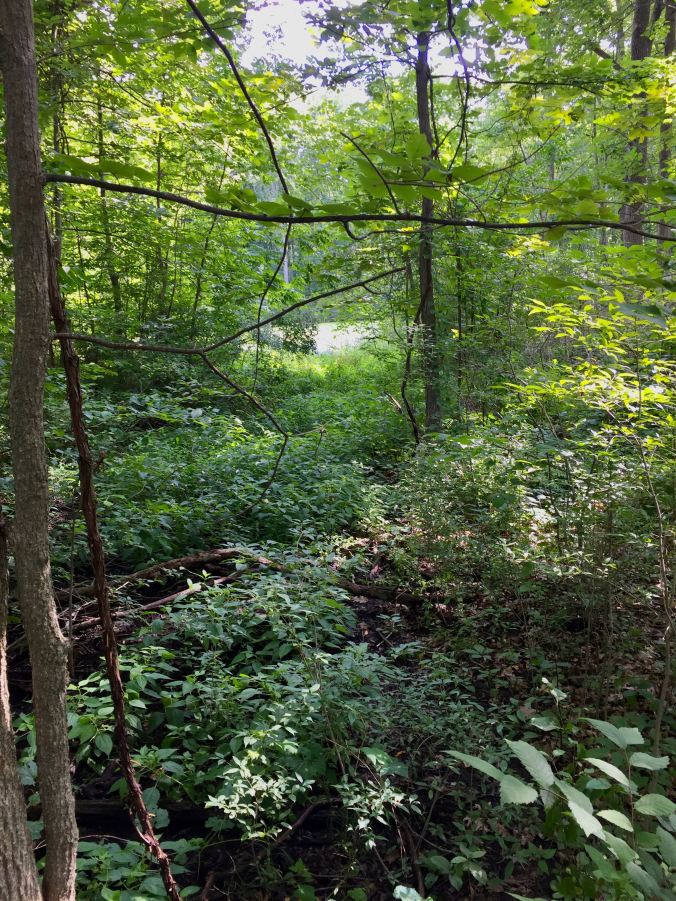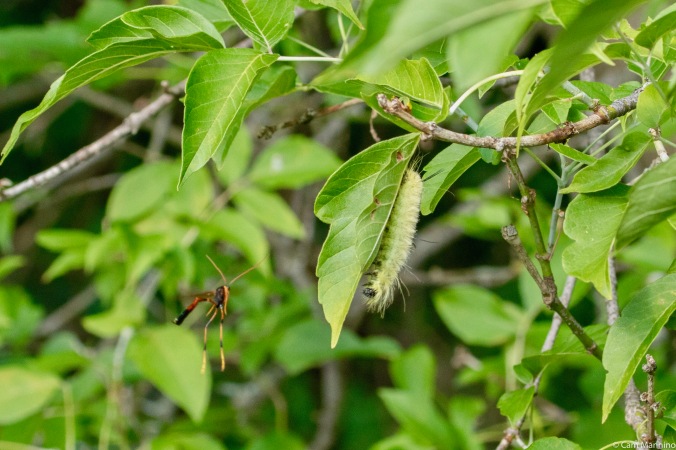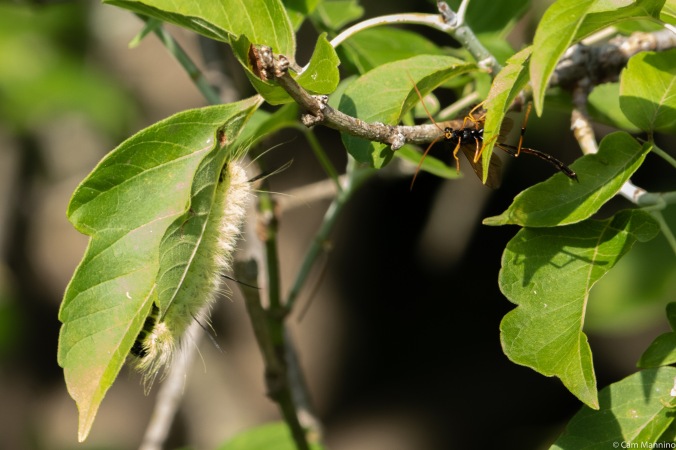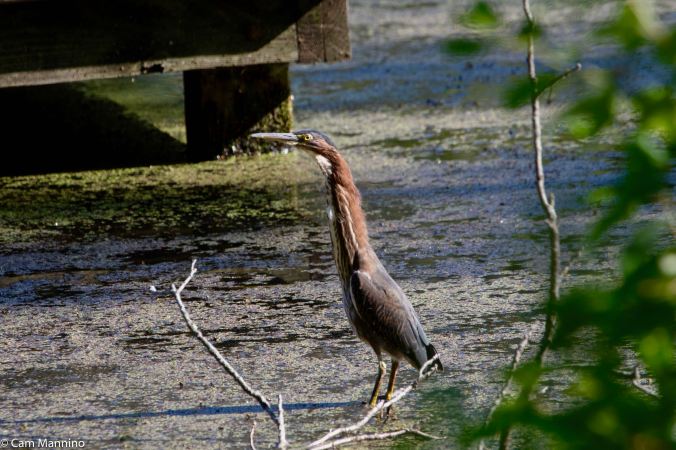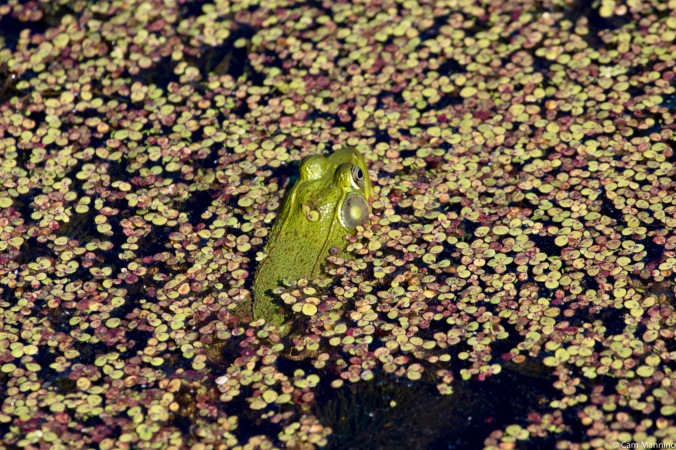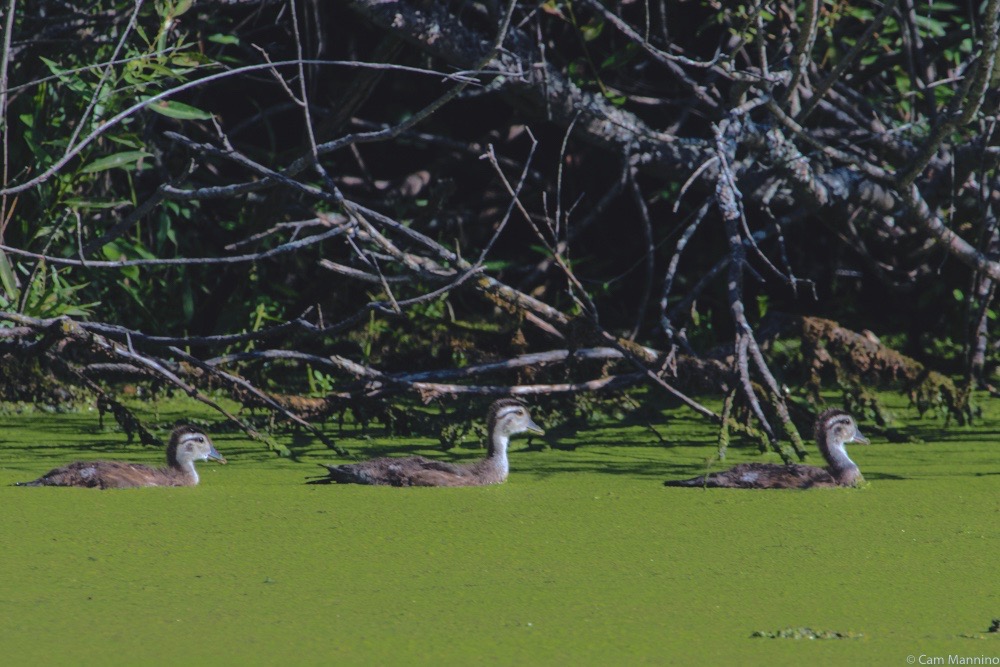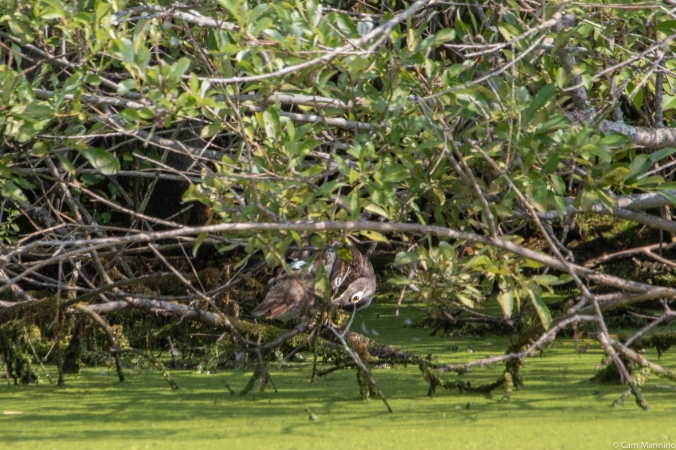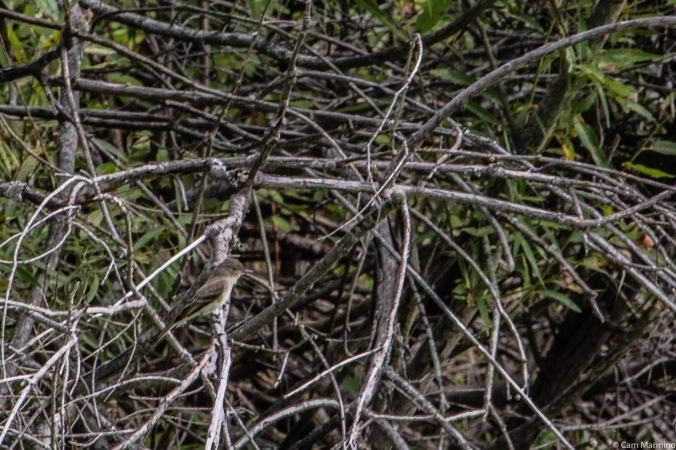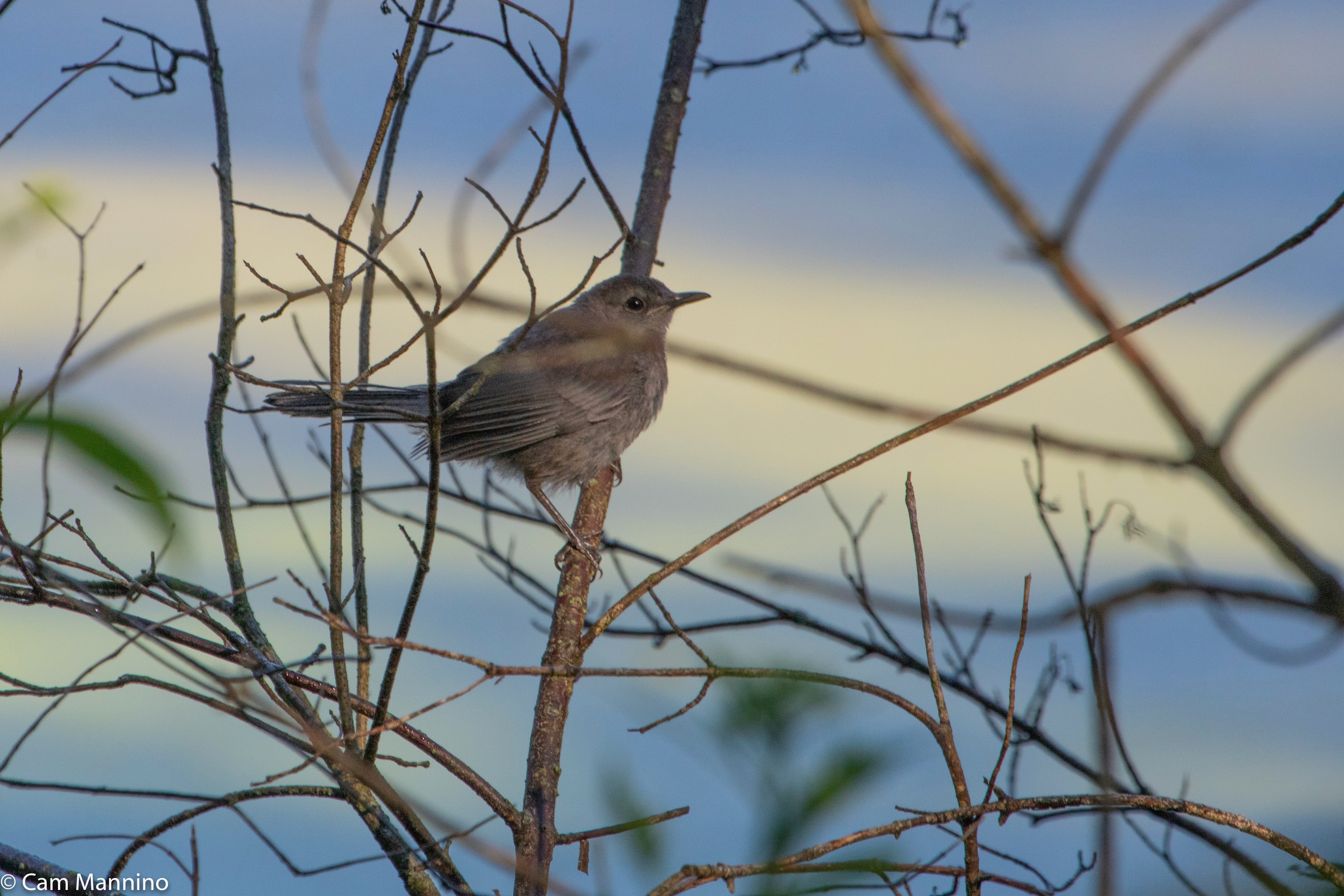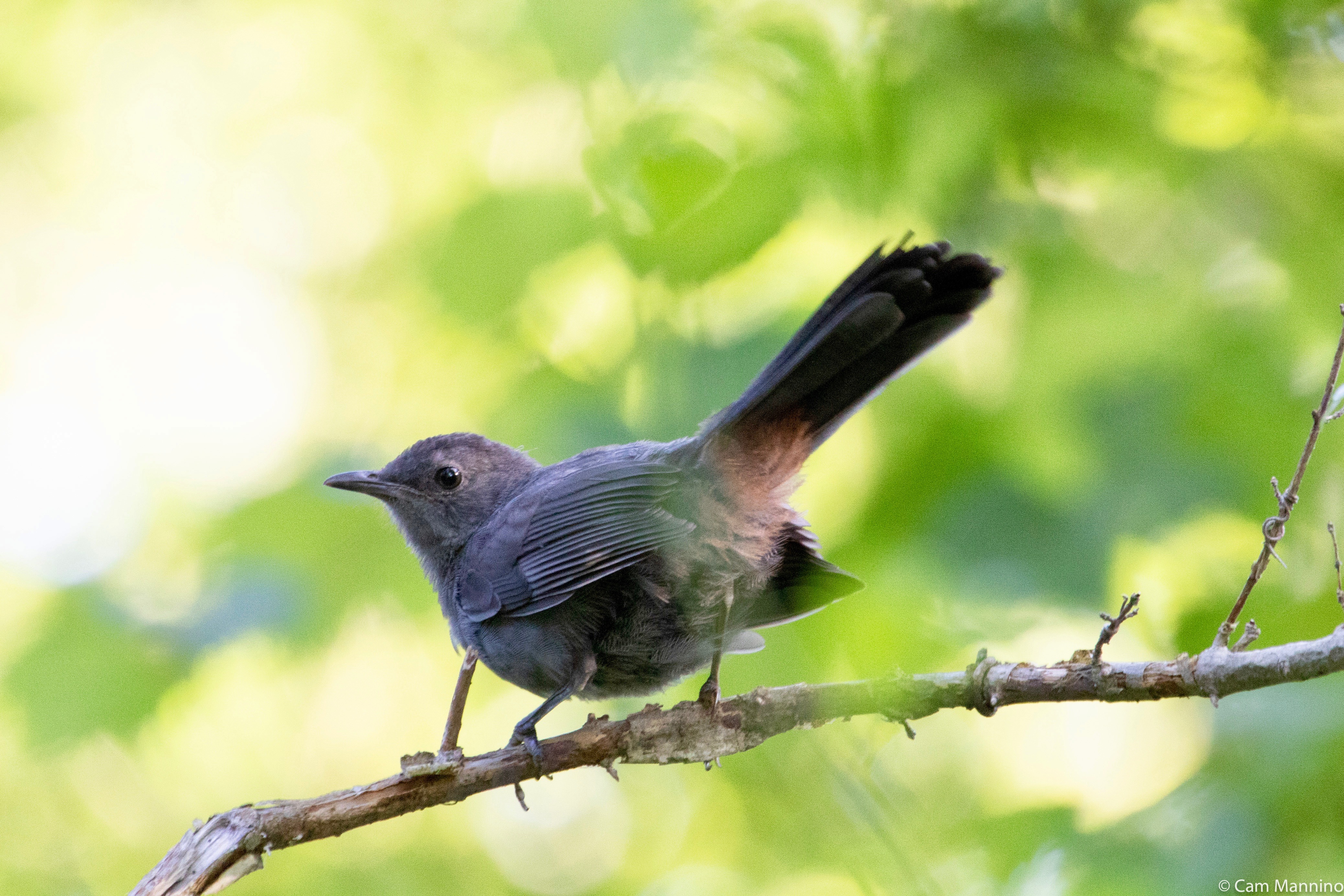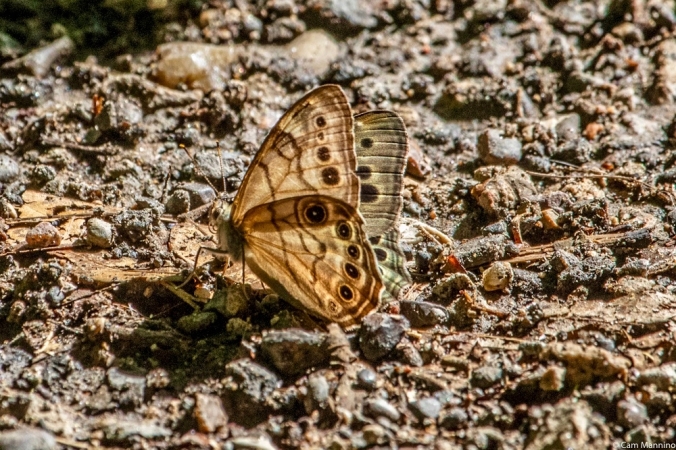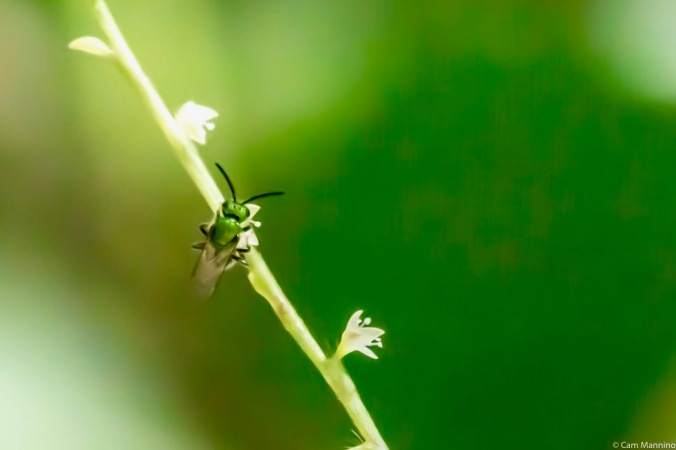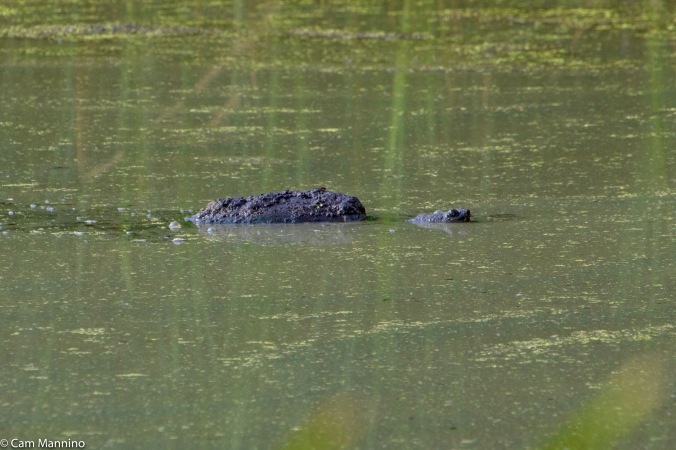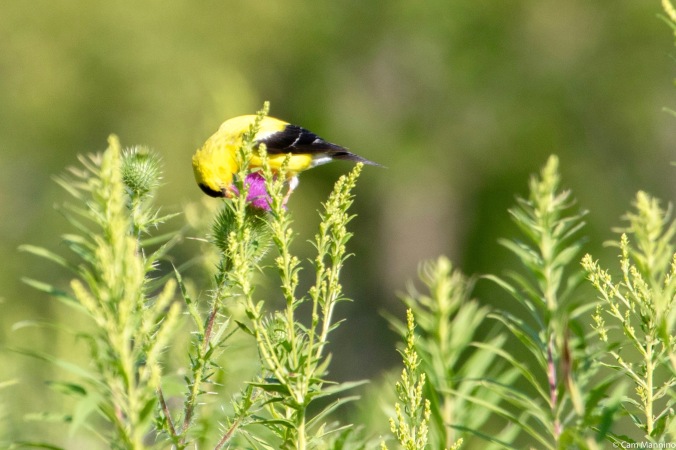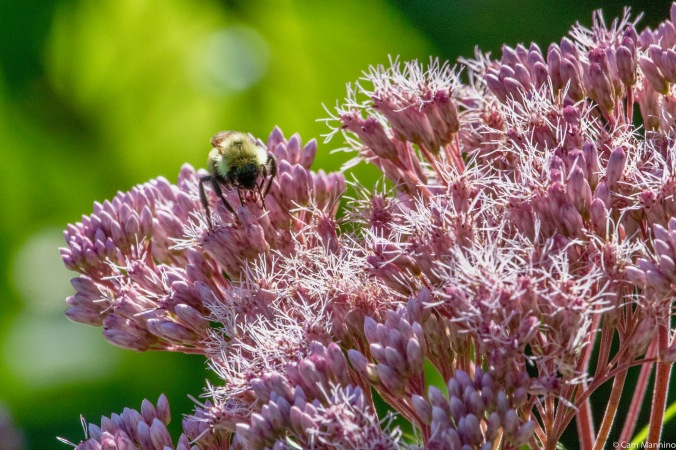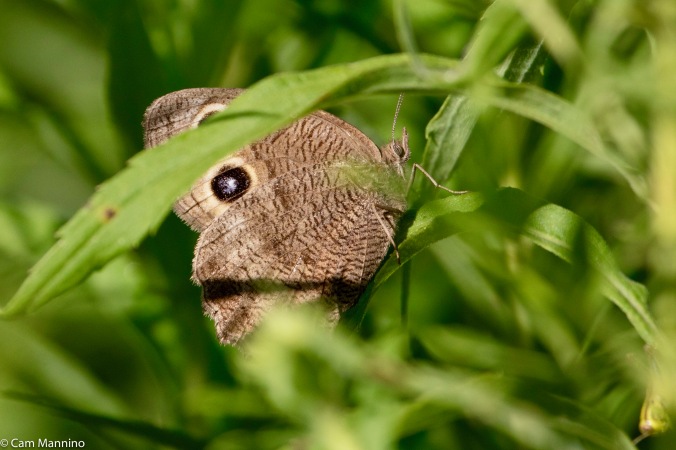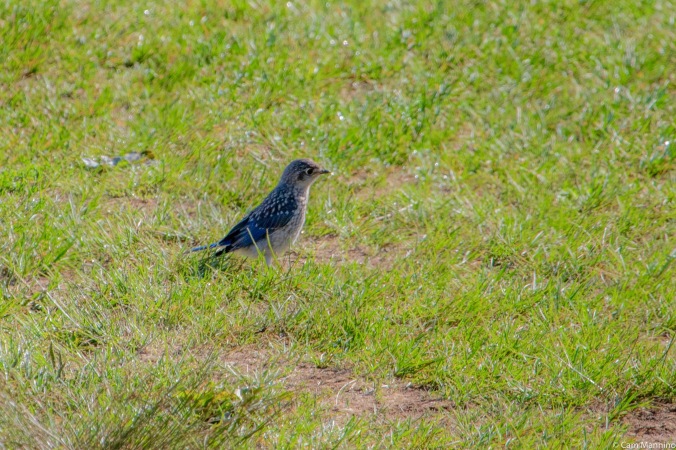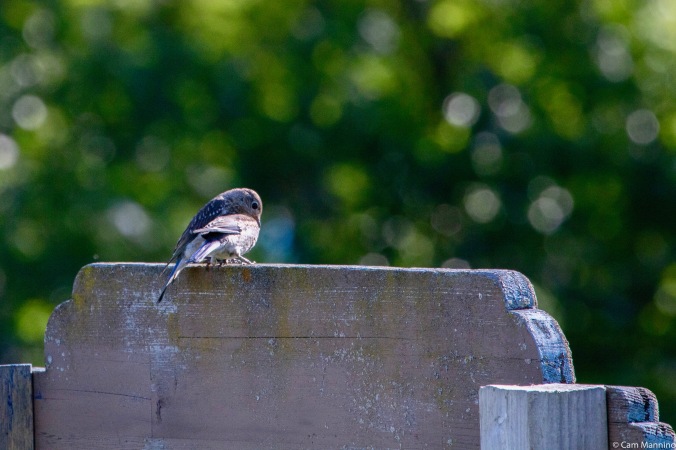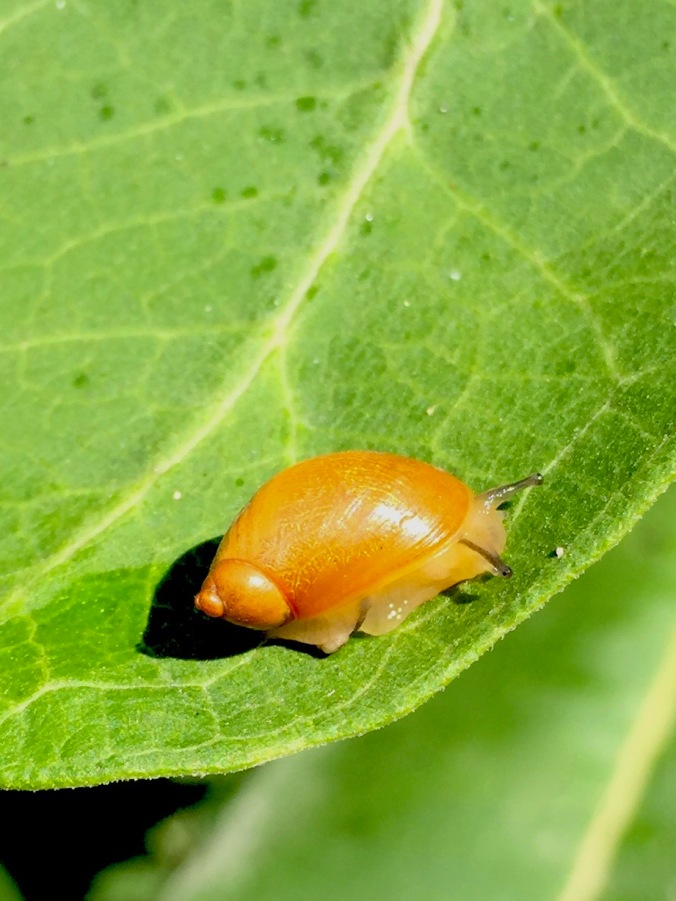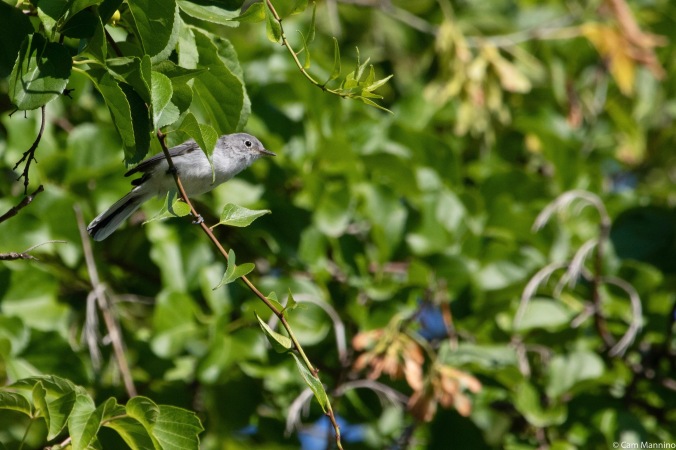Bear Creek Nature Park is the Oakland Township Park I know best. I’ve walked there with my husband Reg for almost thirty years and brought some sort of camera with me for the last thirteen of them. As the winter ebbs each year, we watch for the appearance of the first narrow leaves of Spring Beauty or Blood Root under certain trees. Each May, we check out a huge hole in a particular oak, hoping for a glimpse of this year’s raccoon kits scrambling up and down within in the trunk. My husband has an eagle eye for the slowly moving hulk of snapping turtles gliding across the surface of the marsh and we both listen each summer for the banjo-like strum of the Green Frog’s song at the Center Pond.
But after all these years, we can still be fascinated by something we’ve never seen before, as you’ll see in the life-or-death drama of two determined foes fighting for life on the western slope last week. It’s a fresh experience to watch a trio of Eastern Bluebird fledglings sorting out their relationships in the Eastern Meadow. Amid all the comforts of the turning seasons with their eternal cycles of emerging, blossoming and subsiding, we can still be amazed by the persistence of life. Let me show you what I mean.
High Drama on the Western Slope
My husband and I headed for the western slope one perfect summer day and came upon two small creatures in a life-or-death contest. My husband spotted a large, yellowish/white caterpillar with five spiky, black hairs chewing avidly on a Box Elder leaf (Acer negundo). I learned later from Dr. Gary Parsons, Collection Manager and Bug House Director at Michigan State University’s Etymology Department, that it was the larva of an American Dagger Moth (Acronicta americana). When we stopped to look more closely, we saw a large, exotic-looking insect hovering nearby. Oh boy, I recognized this determined female.
It was an Ichneumon Wasp (family Ichneumonidae), a creature that preys on caterpillars in order to plant its eggs in or on them. When the eggs hatch, the unfortunate victim provides a plentiful source of food for the Ichneumon Wasp’s young!
This female kept her long abdomen with its ovipositor curled upward like a scorpion as she maneuvered near her target. The caterpillar clearly sensed the danger of her presence because it began to rear back its head along its body, thrashing forward each time the insect approached. The wasp first hid under a nearby leaf and then leapt forth, for all the world like a silent movie villain!
The battle went on and on in the bright sunlight. The wasp repeatedly attempted to gain purchase on the caterpillar, but its bristled body and its constant thrashing made depositing the wasp’s eggs extremely difficult.

The Ichneumon Wasp tries to land on the caterpillar but the caterpillars bristles and its thrashing are quite a defense!
They were worthy opponents. We waited a long time but the battle continued to rage – the caterpillar eating the leaf between attacks to keep its energy up and the wasp trying desperately to deposit its eggs on a nourishing food source. Eventually, we left them both to their fate and walked on into the morning.
It was a peaceful change of scene to see male and female Monarch butterflies (Danaus plexippus) settling on plants nearby. I hope they mated and laid eggs earlier since they were landing on Common Milkweed (Asclepia syriaca) that weren’t young and tender, but too dry and tough to provide much nutrition for their offspring. Perhaps they were some of the first Monarchs to start migrating south to Mexico. [Click on photos to enlarge; hover cursor for captions.]
In early August, we saw a female Monarch fluttering among fresh Butterfly Milkweed (Asclepias tuberosa) in the meadow west of the Center Pond. Monarch caterpillars specialize; they only eat milkweed leaves. Perhaps this one’s young are currently nibbling their way along the leaves of this plant, intending to molt, pupate and emerge before the migration.
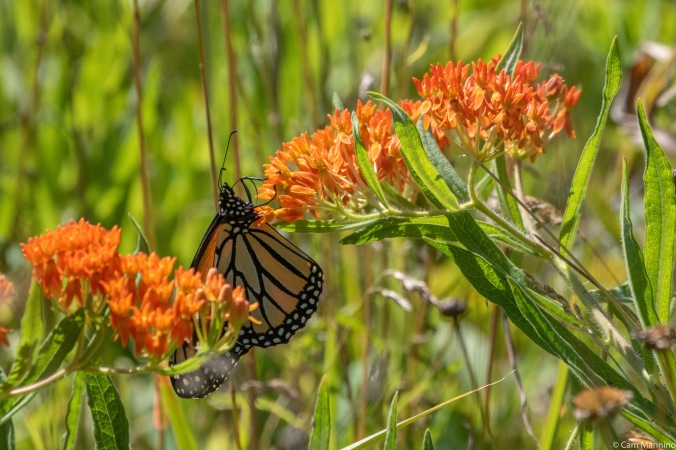
On August 1, we spotted a female Monarch fluttering among Butterfly Milkweed, perhaps eating, perhaps stopping to lay her eggs.
Just a short way along the Western Slope trail, a slightly worn Viceroy Butterfly (Limenitis archippus) settled on Queen Anne’s Lace. Viceroys look very much like Monarchs and recent research indicates that both species use their color to advertise that they are unpalatable to predators. However they can be distinguished from Monarchs by the thin, black lines across the veins of the hind wings. Often, too, they tend to flutter more frequently than Monarchs which beat their wings quickly and then coast for a few moments in flight.
Viceroys have another defense against predators like the Ichneumon Wasp. Their caterpillars look like bird droppings! Here’s a photo of one shared by a photographer who uses the name jdfish1 at inaturalist.org. What a strategy this butterfly evolved for protecting its young!
On to the Pond: A Stealthy Fisher and I Share Strategies
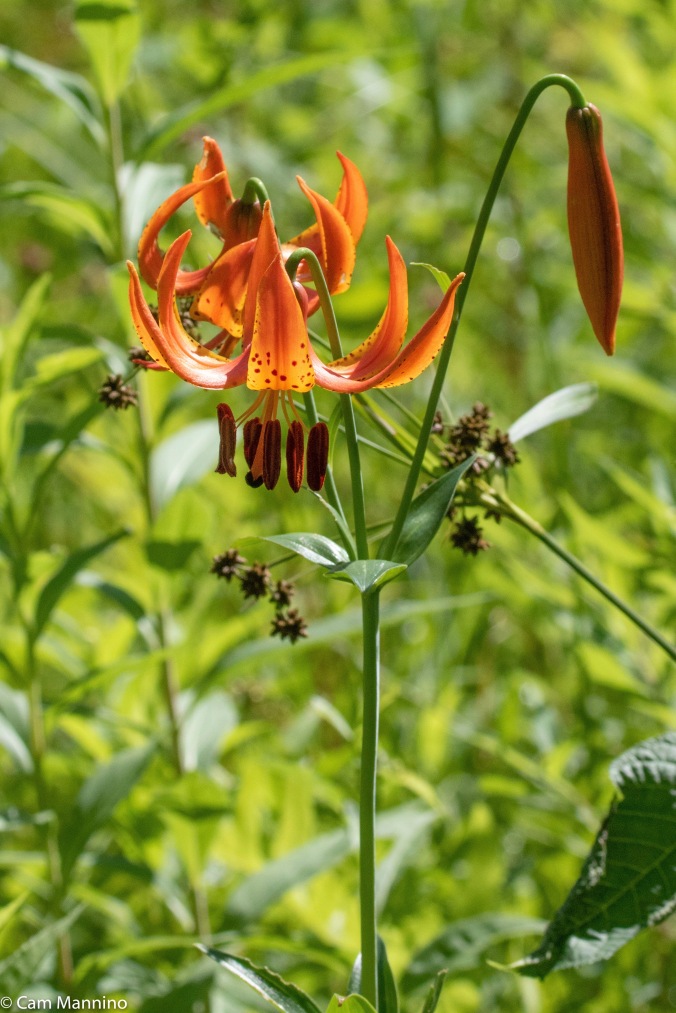
A native Michigan Lily (Lillium michiganense) blooming in a moist area just west of the Center Pond in early August
As I turned down the path that leads to the Center Pond, I was confronted by a wriggling, bristly caterpillar who appeared to be suspended in mid-air right in front of me. The Hickory Tussock Moth (Lophocampa caryae), like the Dagger Moth caterpillar, is covered with bristly hairs that can cause a skin rash if you pick either of them up. Since it pupates in leaf litter after eating on leaves, it was wriggling out an almost invisible string in order to carefully lower itself to the ground. It didn’t look fully grown to me because it hadn’t developed the long black hairs front and back of later instars. I wished it well and passed on.
But after a few steps, I stopped again. A young Green Heron (Butorides virescens) sat preening in a branch near the dock.
I love watching these birds fish, so I approached very cautiously, repeatedly taking a few slow-motion steps each time the heron looked out toward the pond and then pausing when it looked even slightly in my direction. After checking out its feathers, it flew down to stand in the water, stretching out its long neck. It didn’t stay there long; Green Herons often prefer to hunt from a perch rather than wade like the Great Blue Herons, for example.
I continued to stealthily approach each time the heron’s focus turned out toward the pond. And suddenly, it flew to the dock and began to hunt in earnest. I As I watched it verrrry sloooowly step down to the edge of the dock and stretch out its neck to search for prey, a huge smile spread across my face. I almost laughed aloud. I thought, “You and I, Green Heron, have developed the same strategy, except I want a photo and you want a meal!”
It didn’t score a meal that time. It gave up and flew to the other side of the pond. Here’s what it was probably looking for, but couldn’t quite reach – a Green Frog (Rana clamitans) immersed in duckweed, who lived to mate another day.
When I reached the deck, a family of three small Wood Ducks (Aix sponsa) with an adult female were feeding off the bright green Common Duckweed (Lemna minor) on the far side of the pond. Three other young wood ducks cruised around by themselves, far from the others.
- Female wood duck with 3 of her ducklings
- Three other little Wood ducklings off on their own
I’d seen this same grouping at the bird walk a couple of days earlier. This time though, the female spotted me in the distance and disappeared into the vines at the far edge of the pond. When she returned, she appeared to have summoned the male who’d been hiding because he clearly was molting. His gorgeous iridescent green crest and curvy “duck tail” were being replaced by more sedate non-breeding plumage. He and the female quickly stood guard over their family group as if to put me on notice!

The male Wood Duck came out of the vines despite being in molt when summoned by the female to defend the young from that strange person with the camera on the deck.
The other three ducklings came a bit closer to the others, but again seemed to be happy on their own. I wondered if they were from her first brood, since Wood Ducks can breed twice in a summer, though the minimum number in a Wood Duck clutch is usually six. So maybe she just had three slightly more independent offspring and three who needed more protection? No way of knowing.
The male Wood Duck eventually decided I was not a threat and disappeared back into the tangle of vines to work a bit more on his molting process.
My husband and I watched an Eastern Wood-pewee (Contopus virens) sally forth from the shrubbery to hawk for insects. But as soon as it returned to the dead vines at the pond edge, it almost disappeared from view. See how quickly you can spot it here:
As I left the pond, walking along the eastern boardwalk, I heard the “miaou” call of a Gray Catbird (Dumetella carolinensis). One of the birders had pointed out a catbird there earlier in the week and I’d taken a quick photo. But I told the others that I’d always wanted a good photo of the rusty undertail coverts of these birds and I’d never gotten one. Well, two days later, I heard the “miaou” again, and there it was obliging me by showing the part of its anatomy that I’d read about but never caught in a photo.
- The Gray Catbird on the day of the bird walk.
- Likely the same bird showing me his rusty undertail feathers.
In the meadow west of the Center Pond, the Wednesday birding group also spotted a male Indigo Bunting (Passerina cyanea) dropping down into the grass to feed and then quickly rising again to the nearest branch. I got a quick photo then to share with you, but didn’t see the bird again during the week. Keep an eye out when you’re there. He’s a beautiful eye-full, even when looking a bit bedraggled either from parenting duties or perhaps the beginning of his molt.
Out on Bear Marsh with Snappers!
In the woods on the way to the marsh, a movement at our feet caught our attention. A tiny American Toad (Anaxyrus americanus) about 3/4 of an inch long, hopped onto some leaves and froze, hoping perhaps to blend into the background and escape notice; camouflage is a basic survival strategy for toads. Though they breed in shallow water, they spend most of their time on land. I love this little toad’s chubby legs. Small as he is, he’s off into the larger world to feed and if lucky enough to survive, produce another generation of toads.
Along the way, some small white mushrooms stood tall along a seam in a log. Crown-tipped Coral mushrooms (Clavicorona pyxidata) are aptly named. They do resemble undersea corals and their tips are recessed and surrounded by little points. They grow only on dead wood, especially hardwood that has lost its bark. So they are helping to recycle the forest for us and creating this odd, but lovely life form in the process.

This Crown-tipped Coral mushroom is probably at bit past its prime since it’s no longer white. Or it may just not have gotten enough sunlight.
A couple of striking insects also appeared as we passed through the wood toward the marsh. A Northern Pearly Eye butterfly (Enodia anthedon) landed in a bare spot on the trail, sunlight shining through its wings. This butterfly doesn’t feed on flowers, but on tree sap, rotting fruit, decaying vegetation, even carrion – transforming death back into life. The life cycle of butterflies is full of amazing transformations, so why not one more?
Dr. Gary Parsons of MSU also helped me identify this cartoonishly cute, metallic native bee near the marsh as being from the family Halictidae. They are commonly called Sweat Bees, the ones that are attracted to your perspiration. But this tiny one was sipping from the drying blossoms of a native wildflower called Jumpseed (Persicaria virginiana), so called because according to Michigan Flora, if the plant is disturbed, it can propel mature seed about 9 feet, a nifty means of dispersal!
At least six Common Snapping Turtles (Chelydra serpentina) moved slowly through the water at Bear Creek Marsh, their shells looking like moving clumps of mud. Snappers are generally shy and harmless except when bothered on land. Their plastron (the lower shell) is small, leaving parts of its body exposed and vulnerable. They can’t completely disappear inside their shell and be safe like many turtles. So on land, their only protection is flinging out their very long necks and biting. Snappers clean our lakes and marshes of bacteria much like vultures clean our land, by consuming underwater carrion, but unlike vultures they also forage for live prey and aquatic vegetation.
The edge of the dock at the northern entrance to the marsh is blooming with Arrowhead (Sagittaria latifolia), a lovely aquatic plant that produces white flowers sprouting from both sides of a stalk or “raceme”- and the large, vivid arrow-shaped leaves are almost more beautiful than the flowers! Dragonflies cling to them like bright baubles. What a sight on a summer morning!
The Eastern Meadow: Young Birds Out on Their Own..Sort Of
The Canada Goldenrod (Solidago canadensis) is just getting ready to turn the meadow gold. A male American Goldfinch (Spinus tristus) stood on a thistle and happily tore off some of the Goldenrod buds, possibly to feed either his mate or young. Goldfinches don’t start breeding until late summer when the thistles provide down for nests and seeds for growing broods.
Once he looked up and saw my camera, he gave me a wary glance but went right back to foraging.
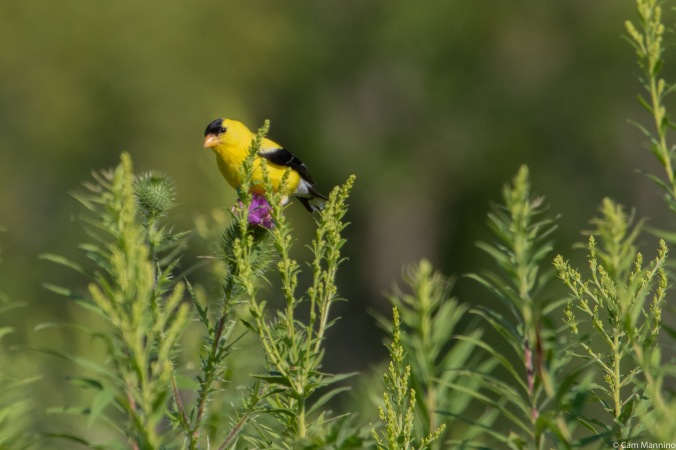
A male Goldfinch giving me and my camera careful consideration before returning to eating or gathering seeds.
Joe Pye (Eutrochium maculatum) blooms in soft patches of bright pink blossoms with purple stems along the eastern trail. There’s just enough moisture to keep their “feet wet,” and the Bumblebees (genus Bombus) hum contentedly as they search for nectar from both the buds and the shaggy, open blooms.
A Common Wood Nymph (Ceryonis pegala) butterfly bobbed along pausing periodically in the deep grass. I mistook it at first for the Little Wood Satyr because they look similar. But the Wood Nymph is almost twice as big and frequents grassy fields while Wood Satyrs prefer shady woods or wood edges. The Wood Nymph also appears a bit later in the summer than the Wood Satyr. Glad my source, Butterflies of Michigan by Jaret C. Daniels set me straight!
When I first saw three fledgling Eastern Bluebirds (Sialia sialis) near the top of the trail, they were all sitting on a sign together. But as I approached, two of them rose into the air and began mock fighting, banging into each other, flying away, settling for a moment, and then mock fighting again. They were too quick for me to snap a photo. Meanwhile the third little bluebird went off on its own, first looking about and then pecking quietly in the grass as it had no doubt seen its parents do.
Eventually it flew to a bare tree far off in the field and calmly surveyed the whole field. The blue on its wing tips and tail feathers was much more apparent in the full morning sunlight.
The two more social siblings finally settled next to each other on the edge of a sign. After all that mock fighting, they snuggled up against each other – though I wonder if an ornithologist would tell me that the play fighting was dominance behavior and the positioning of the one fledgling’s head over the neck of the other meant that they had settled the pecking order between them.
I later spotted two fledgling Bluebirds next to a male adult in a tree along the Walnut Lane. I wondered if the two fledglings were the scrappy pair who rested on the sign. All three seemed to be focused on the field. Maybe they were looking for the solitary fledgling who preferred to be off on its own. It was fun to imagine family dynamics among bluebirds.
What I think was a small Amber Snail (family Succinea) left a shining trail behind it on a milkweed leaf as I left the Eastern Meadow. Amber snails are described as land snails but they also live in moist environments. I was a bit surprised to see one out in the sunshine when we’ve had such blistering hot days this summer!
At the curve of the path that leads to the Walnut Lane, a busy adult Blue-Gray Gnatcatcher (Polioptila caerulea) did its best to keep up with a very flighty fledgling that begged insistently as it bounced from branch to branch. As you can see from the slight blur in its photo below, I had some trouble keeping up with the youngster myself! Dr. Ben VanderWeide, our township Stewardship Manager, showed me a Gnatcatcher nest that fell near his home. So imagine how tiny that fledgling had to be at birth to fit in that lovely nest with possibly as many as four other hatchlings! Look for the white eye ring and the white feathers on either side of the dark tail feathers to identify these active little birds.
A Short Trip Through More Summer Blooms

A glorious abundance of Cardinal Flower (Lobelia cardinalis) below the boardwalk north of the playground.
I couldn’t detail all the wildflowers and grasses that I enjoyed at Bear Creek Nature Park in the last week, so take a short stroll through the rest of them here. Their color adds so much joy to a summer walk!
Life Calls Us Out to Explore
Reg and I met twenty-month-old Henry trotting along the path west of the Center Pond as his parents took a rest on a nearby bench. He looked content to just keep moving up the trail, seeing what he could see. It was clear he was happy to be there. Henry reminded me of the third Bluebird fledgling that I described earlier – happy to be off on his own, exploring the big beautiful world that he’s just beginning to understand.
What’s so great is that Henry’s experience is accessible to all of us, no matter our age. If we get out in the natural world with our curiosity and eyes wide open, we can’t help being surprised and delighted by it all – even two small insects determined to fight the other off to pass on their DNA to a new generation. Bird parents exhaust themselves caring for their young. Wildflowers fight their way up out of hard soil to bud, bloom and send their seeds forth into the world. Butterflies, turtles, even fungi recycle death back into life. Life in all its multifaceted glory keeps struggling to persist. And it’s our responsibility as stewards of this glory to keep working hard to make that possible. Here in Oakland Township, the residents have made a commitment to support that call to stewardship – and even in the midst of a tough 2020, I think that’s something to celebrate. Bet you do, too.
